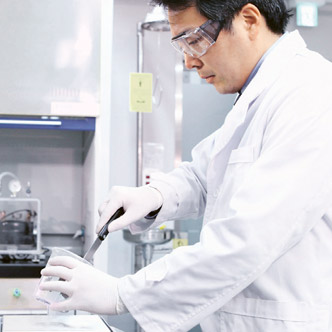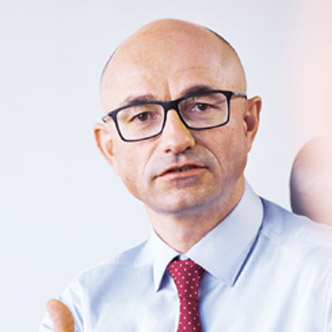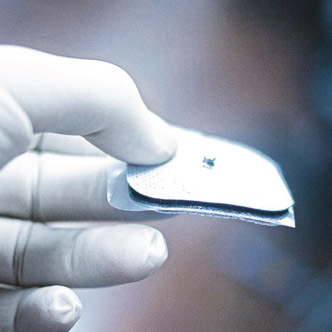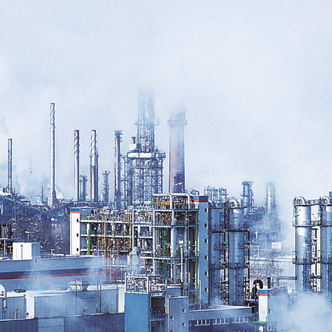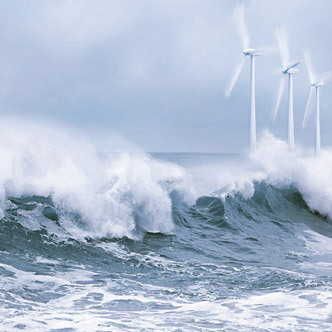WACKER Stock in 2016
WACKER’s share price was influenced by a variety of factors during 2016. They included business developments in the European chemical industry, polysilicon prices and semiconductor-sector demand. Negative reports on specific topics, but also macroeconomic events such as Brexit and the economic trend in China, led to strong price fluctuations, particularly in the first half of the year. In the final third of the year, WACKER’s stock price rose markedly, spurred by Siltronic’s positive value trend, by the ongoing strength of business at WACKER’s chemical divisions, and by the polysilicon market’s price recovery amid continued robust demand.
Concerns about the future economic trend in China and the expansionary monetary policy of the major central banks in the USA and Europe dominated international financial-market sentiment in the first quarter of 2016. Investors were unsettled by the turbulence in the Chinese stock markets early in the year. The losses on Asian stock markets and the Chinese economy’s marked slowdown put substantial pressure on stock prices, especially those of major exporting companies, dragging down key indices worldwide. In response to low inflation and continued deflationary fears in Europe, the European Central Bank (ECB) decided on March 10 to lower its main refinancing rate to zero percent for the first time ever. Following significant losses at the start of the year, Germany’s DAX and MDAX indices had recovered somewhat by mid-February. The DAX dropped around 3 percent overall, while the MDAX closed unchanged compared with the beginning of the year.
Despite the unfavorable financial-market conditions, WACKER stock performed somewhat better than these two German benchmark indices in the first quarter of 2016. The shares opened trading in Q1 2016 at €75.61. In line with the general stock-market trend, the price initially fell, touching its low for the year of €58.73 on February 11. The stock made up that lost ground in the following weeks, closing at €77.34 on March 31.
Global stock markets were uneven and volatile in Q2 2016. Accommodative monetary policy in Europe and the USA once again supported share prices in April. But later in the quarter, the markets were increasingly dominated by concerns about a possible British exit from the European Union and its impact on the world economy. There was also speculation about the US Federal Reserve possibly raising the federal funds rate. Both of these developments unsettled the international financial markets and pushed down the world’s major market indices.
At their June meetings, both the European Central Bank and the Federal Reserve left their key interest rates unchanged. The negative outcome of the referendum in the United Kingdom caught many market participants off guard, however. After the result was announced on June 24, the pound plunged to its lowest level against the US dollar in 31 years. The world’s major stock indices fell by over 10 percent at times. Not until the end of the month did the markets regain some ground.
After getting off to a good start, the DAX and MDAX indices trended sideways in May. By the end of the second quarter, the two indices recovered at least part of the substantial losses triggered by the UK vote to exit the EU. On balance, the DAX dropped around 1 percent in the April-through-June quarter, while the MDAX finished June trading down 2 percent.
Despite the difficult conditions in the financial markets in the second quarter, WACKER stock outperformed both the DAX and the MDAX. The stock opened Q2 2016 trading at €76.48 and closed at €78.46 on June 30, almost 3 percent higher than at the start of the quarter and equivalent to a market capitalization of around €3.9 billion.
Global stock markets performed solidly in Q3 2016. After a slow start in early July, initial concerns about Brexit and its potential global economic impact increasingly receded.
From August onward, the world’s major equity indices began to recover, mainly due to the fact that interest rates remained low in the USA, while Europe and Japan continued to pursue accommodative monetary policy. Germany’s main equity benchmark, the DAX, gained around 8 percent from the beginning of July through the end of September, posting its first positive quarter of the year. The MDAX also rose in Q3 2016, gaining 7 percent.
WACKER stock started Q3 2016 at €80.03, initially trending upward in line with the DAX and MDAX. On July 27, it posted its high for the quarter of €87.49. In the weeks that followed, the stock largely moved sideways. Then came a period of extensive pressure, beginning in early September. One reason for this was rising concern among market participants about future developments in the solar industry. It was reported, for example, that the People’s Republic of China had already achieved its target of around 20 gigawatts in new photovoltaic capacity for the full year in the first half of 2016. In response, prices and volumes fell in September. WACKER stock gradually declined to reach its third-quarter low of €71.50 on September 23. It did recover some ground by the end of the quarter. On balance, however, WACKER stock lost around 6 percent from the beginning of July through the end of September, closing the three-month period at a price of €75.00, equivalent to a market capitalization of around €3.7 billion.
The fourth quarter was influenced by the outcome of the US elections on November 8. Initial uncertainty in the markets turned into positive expectations as to the future development of the US economy under a President Donald Trump. The US dollar gained substantially against the euro during November and December. The DAX climbed by 8.1 percent in Q4 and the MDAX by 2.3 percent.
WACKER’s share price moved upward, outperforming the two German benchmark indices by a wide margin. In early October, WACKER held its annual Capital Market Day in Burghausen. The company’s Executive Board and senior management used the occasion to introduce the new corporate strategy and discuss current market developments. The stronger-than-average increase in the share price at year-end was driven by the rapid recovery in demand for high-quality polysilicon, by the positive business trend for chemicals, by favorable earnings expectations for Siltronic and by exchange-rate effects. From the beginning of October through year-end, WACKER stock gained 28.9 percent, advancing from €76.69 to €98.85, and reached its year-high on the last trading day of the year. The market capitalization at year-end was €4.9 billion.
During the year, discussions with capital-market participants were dominated by questions about market equilibrium with regard to polysilicon and the announced exit from Siltronic. In addition, there was increasing focus on the success and market prospects of the chemical divisions.

